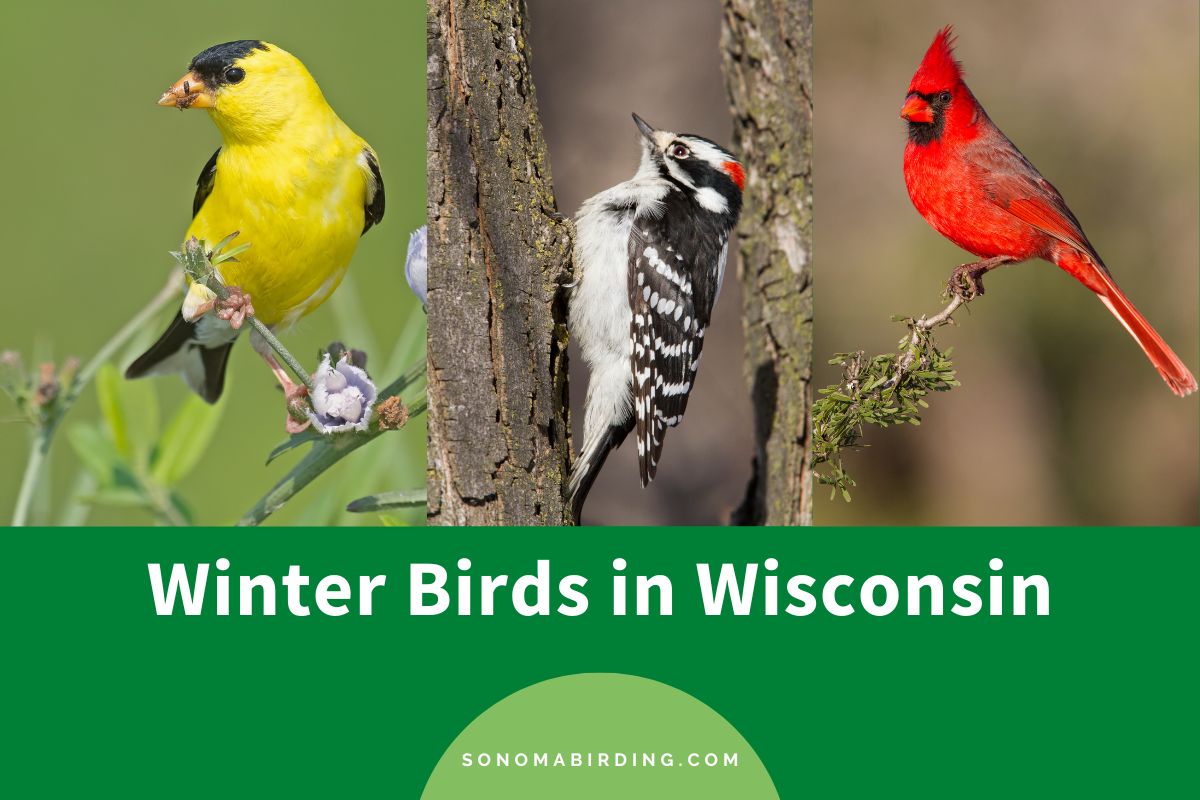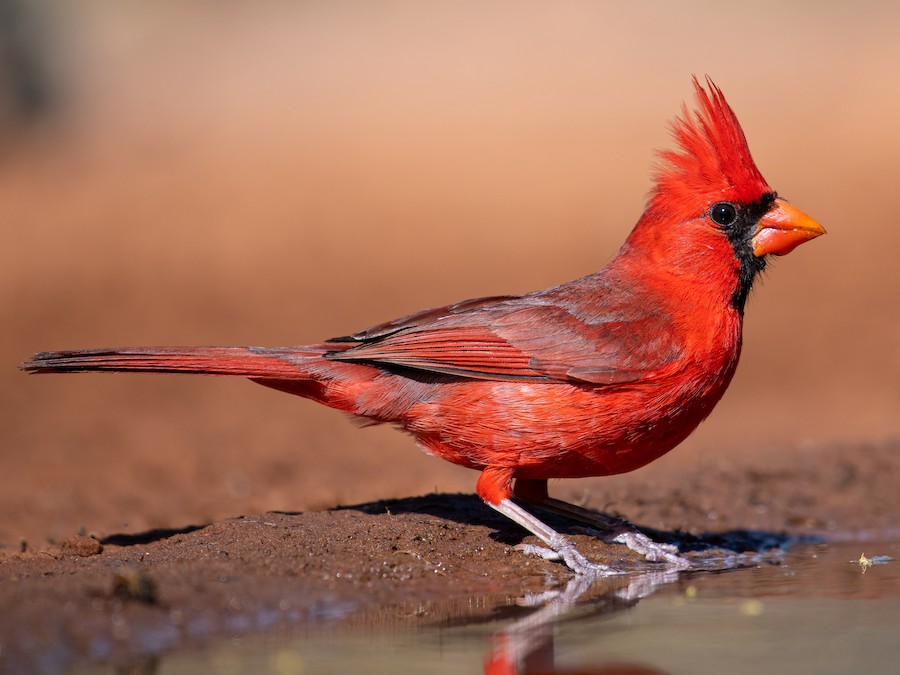Wisconsin is home to many different types of birds, and during the winter months, you can spot some beautiful ones. From Northern Cardinal to White-breasted Nuthatch, we’ve put together 15 of the most common winter birds in Wisconsin. Take a look and see if you can spot any of them near your home!
Let’s get started!
1. American Goldfinch
Scientific name: Spinus tristis
Length: 11-14 centimeters (4-5 inches)
Body mass: 11-20 grams
Average lifespan: 3-6 years
The American Goldfinches are tiny migratory songbirds belonging to the Finch family. These birds are members of the cardueline finch subfamily and happen to be the only species to undergo a complete molt twice annually within it.
The adult American Goldfinches display sexual dichromatism, with both sexes having differently-colored plumages. The males also have separate spring and autumn plumage, with the spring plumage being the brighter one to attract a mate.
In spring, the males have an overall lemon-yellow plumage with a striking black cap atop their heads. Their back is colored the same, except for black wings and tails with white bars on them. Only their rump is white, which is visible in flight.
In autumn, the males are only left with a faint yellow face and bib, while the rest of their upper body is colored in olive brown, and the underbody is buff. The females closely resemble the autumn plumage of the males; only their face is darker. Both sexes have dark eyes, bone-colored bills, and legs.
When are these birds found in Wisconsin?
American Goldfinches are a resident species in Wisconsin, found in the state throughout the year.
2. Dark-eyed Junco
Scientific name: Junco hyemalis
Length: 13-17 centimeters (5-6 inches)
Body mass: 18-30 grams
Average lifespan: 3-11 years
Commonly found in the temperate regions of North America, the Dark-eyed Juncos are small passerine birds belonging to the New World Sparrow family. Much like their close relative, Fox Sparrows, this species is highly variable, with about 15 different recognized subspecies.
While all these subspecies have subtle differences in their appearance, as a general rule, all of their heads, necks, and chests are grey, with white undersides. Their backs, wings, and tails range from brown to dark grey, with varied markings on them.
Both sexes of these juncos are identical in appearance and have dark eyes, pale bills, and legs; only the males have more defined markings than their female counterparts.
When are these birds found in Wisconsin?
While Dark-eyed Juncos are permanent residents in the northern parts of Wisconsin, during winters, they can be found throughout the state.
3. Downy Woodpecker
Scientific name: Dryobates pubescens
Length: 14-18 centimeters (5-7 inches)
Body mass: 20-33 grams
Average lifespan: 1-2 years
Closely resembling the larger Hairy Woodpeckers, the Downy Woodpeckers are a small woodpecker species, the smallest one found throughout North America.
These woodpeckers have a classic black-and-white appearance. Their head, back, wings, and tails are all black, except for a bold white stripe on their back. Two white bars run across their otherwise black face (one above their eyes and the other one below).
Their black wings are marked with white spots, more heavily in the males than in females. The males also possess a red patch on their heads that’s absent from their female counterparts. Their eyes are dark, while their legs and pointed bills are grey.
When are these birds found in Wisconsin?
While Downy Woodpeckers are permanent residents in Wisconsin, they’re a more common sight on backyard feeders during winters.
4. Northern Cardinal
Scientific name: Cardinalis cardinalis
Length: 21-23 centimeters (8-9 inches)
Body mass: 33-65 grams
Average lifespan: 3 years
Locally referred to as Redbird, the Northern Cardinals are medium-sized cardinals dwelling in the shrublands, wetlands, and gardens of North America. These songbirds are popular both for their songs as well as for the striking appearance of the males.
The adults of this species display a strong sexual dimorphism in both their plumage and size. The males, being the large sex, have an overall brilliant crimson plumage with their bills and legs colored the same. They possess a black face mask that extends over their eyes, and their wings and tail are darker.
On the other hand, the smaller females have olive-colored faces and back with paler chests and white underparts. Their wings and tails are colored in greyish brown with touches of crimson.
When are these birds found in Wisconsin?
Northern Cardinals are year-round residents of Wisconsin and are equally common on backyard feeders in both summers and winters.
5. House Sparrow

Scientific name: Passer domesticus
Length: 16 centimeters (6.3 inches)
Body mass: 24-39 grams
Average lifespan: 3 years
Belonging to the True Sparrow genus, the House Sparrows are considered the most widely distributed wild birds in the world. Although these birds are endemic to Europe and Asia, you can find them in Africa, Australia, and the Americas as an introduced species.
Much like the other sparrow species, the plumage of House Sparrows is also colored primarily in brown and grey. Adults display sexual dimorphism in plumage and size, with the males being slightly larger than their female counterparts.
The head of the male is grey, with brown stripes running on the side of their crown, black lores, and chin stripe. Their underparts are grey, growing paler towards the rump, while the upperparts are warm brown with heavy black streaking.
The females are a paler version of their male counterparts, except their head isn’t grey but pale brown, and they lack black lores. Both sexes have dark eyes, conical grey bills, and pale legs.
When are these birds found in Wisconsin?
Despite being an introduced species in both the country and the state, House Sparrows have adapted well in Wisconsin and are as common in the state as any other native bird.
6. Black-capped Chickadee
Scientific name: Poecile atricapillus
Length: 12-15 centimeters (4-5 inches)
Body mass: 9-14 grams
Average lifespan: 2-3 years
Declared the state bird of Maine and Massachusetts in the United States, the Black-capped Chickadees are tiny songbirds that dwell in the mixed and deciduous forests of North America. They’re also the provincial birds of New Brunswick, Canada, which signifies their popularity throughout their range.
As their name suggests, these little birdies have a bold black cap atop their head which also covers their eyes. They also have a black bib below their chin, with only their cheeks being white. Their underbody is entirely white except for pale brown flanks, while the wings are greyish and have dark edges.
Both sexes of these birds appear identical in plumage and possess the same dark eyes, bills, and legs; only the males grow larger than their female counterparts.
When are these birds found in Wisconsin?
Black-capped Chickadees are year-round residents of Wisconsin and are spotted on backyard feeders in both summers and winters.
7. White-breasted Nuthatch
Scientific name: Sitta carolinensis
Length: 15.5 centimeters (6 inches)
Body mass: 18-30 grams
Average lifespan: 2 years
The White-breasted Nuthatches are medium-sized birds with an abundant distribution throughout the low-altitude woodlands and deciduous forests of North America. Although these nuthatches have 7-9 recognized subspecies, they show more difference in vocalizations than in plumage.
They have white faces and underparts, with a black crown, bluish-grey upperparts, and dark wing edges. There are touches of warm brown on their rump that you can see both in flight and when perched.
Although both sexes look more or less similar, the females have narrower bands on their heads and overall paler plumages. Both sexes have dark eyes, legs, and pointed grey bills.
When are these birds found in Wisconsin?
White-breasted Nuthatches are permanent residents of Wisconsin and can be found in the state in every season.
8. Red-bellied Woodpecker

Scientific name: Melanerpes carolinus
Length: 22-26 centimeters (9-10 inches)
Body mass: 56-91 grams
Average lifespan: 12 years
The Red-bellied Woodpeckers are a non-migratory woodpecker species with a dense population throughout the United States. Although they’ve been named after the faint reddish blush on their underbelly, people often confuse them with the Red-headed Woodpeckers due to the reddish cap on their crown.
Red-bellied Woodpeckers have a pale grey face and plumage, except for their black-and-white barred wings and tails. Although both sexes appear similar, their head caps are a major distinction between them.
While the caps of the males extend all the way to their bills, in females, it ends at the back of their heads, with only a small red patch above their bills. Both sexes have dark eyes, grey legs, and long, pointed grey bills.
When are these birds found in Wisconsin?
Red-bellied Woodpeckers are permanent residents in southern Wisconsin, spending both their breeding and non-breeding seasons here. However, you won’t find them in the northern parts of the state.
9. Blue Jay
Scientific name: Cyanocitta cristata
Length: 22-30 centimeters (9-12 inches)
Body mass: 70-100 grams
Average lifespan: 7 years
One of the prettiest members of the Corvid family, the Blue Jays are a jay species endemic to eastern North America. As their name suggests, these birds have a primarily blue plumage.
They have a white face and azure crest, with distinct black markings around their eyes and throat. Their underparts are white with a cerulean blue back and sky-blue wings and tail with bold black and white bars.
The eyes, bills, and legs of these corvids are all black, with both sexes appearing identical in plumage; only the males are slightly larger in size.
When are these birds found in Wisconsin?
Blue Jays are year-round residents of Wisconsin and enjoy gathering around oak trees to feed on their favorites: acorn seeds.
10. European Starling
Scientific name: Sturnus vulgaris
Length: 20 centimeters (8 inches)
Body mass: 58-101 grams
Average lifespan: 2-3 years
Although the European Starlings are endemic to the temperate regions of Europe, they reside as an introduced species in many parts of the world, including Australia, Canada, Mexico, and the United States.
These birds have an overall glossy black plumage with sheens of green and purple and white spangles that gain more prominence during winters. Although both sexes of adults might appear similar from afar, up close, they’ve several differences.
While both sexes have yellow bills, the base is pink in the females and bluish-grey in the males. The females also possess more spots on their underparts and smaller, more pointed throat feathers than the males.
When are these birds found in Wisconsin?
European Starlings are year-round residents of Wisconsin and are commonly spotted around gardens, sidewalks, and lawns, mostly in large flocks.
11. American Crow
Scientific name: Corvus brachyrhynchos
Length: 40-53 centimeters (16-21 inches)
Body mass: 316-620 grams
Average lifespan: 7-8 years
Commonly found throughout North America, the American Crows are large passerine birds from the Corvid family. These crows take after the Carrion Crows in appearance but are smaller and leaner.
The plumage of American Crows is iridescent black overall, including their eyes, bills, feet, and legs. Both sexes appear identical in their plumage, with the males being the larger ones in size.
When are these birds found in Wisconsin?
A large population of American Crows gathers in Wisconsin during winters to sleep in communal roosts. However, little is known about their exact time of arrival in the state.
12. House Finch
Scientific name: Haemorhous mexicanus
Length: 12.5-15 centimeters (5-6 inches)
Body mass: 16-27 grams
Average lifespan: 11 years
Closely related to the Purple Finches, the House Finches are songbirds endemic to the western regions of North America and have been introduced in the other half.
These little birdies have an overall buff plumage with brown markings scattered all over them. You’ll spot touches of dark grey on their wings and square-tipped tails; these are paler in the females.
The best way to distinguish between the sexes of this species is through their head and chest. The males have a reddish wash covering these parts, which is absent in their female counterparts. The intensity of this coloration depends on their diet and, thus, shows variation all year long.
When are these birds found in Wisconsin?
House Finches are permanent residents in the southern and southeastern regions of Wisconsin but are absent in other parts of the state.
13. Mourning Dove

Scientific name: Zenaida macroura
Length: 31 centimeters (12 inches)
Body mass: 112-170 grams
Average lifespan: 1.5 years
Also referred to as Turtle Dove and Rain Dove, the Mourning Doves are one of the most popular gamebirds in North America. These birds have an abundant population throughout the continent and have been named after their sorrowful songs.
Mourning Doves have rather slender bodies with long, tapered tails. Their heads and upper parts are pale greyish-brown, with a pinkish touch on their underparts. Their wings have occasional black spotting with white outer tail feathers. Their dark eyes are surrounded by white eyerings; legs are pink, and bills are grey.
Both sexes of adults have subtle differences in their appearances. The males have pale bluish touches on their crowns and pinkish patches on the side of their necks. Both of these are absent in the females, that are also slightly smaller in size.
When are these birds found in Wisconsin?
Mourning Doves are year-round residents of Wisconsin and are commonly spotted throughout the urban and suburban areas of the state.
14. Pine Siskin
Scientific name: Spinus pinus
Length: 11-14 centimeters (4-5 inches)
Body mass: 12-18 grams
Average lifespan: 10 years
Named after their fondness for pine seeds, the Pine Siskins are migratory birds belonging to the Finch family. They’re about the same size as the American Goldfinches but with a much duller coloration.
These siskins have brown upper bodies and paler underparts, with heavy streaks present all over their bodies and variable yellow patches on their wings. They have dark eyes, legs, and dark, conical bills. The adults of this species are sexually monomorphic, with both sexes appearing identical.
When are these birds found in Wisconsin?
While Pine Siskins are migratory birds, their migratory routes and patterns are highly irregular. That’s why it’s difficult to determine exactly when these finches arrive in Wisconsin. What we know for sure is that they’re commonly found statewide during winter.
15. Hairy Woodpecker
Scientific name: Leuconotopicus villosus
Length: 17-26 centimeters (7-10 inches)
Body mass: 40-95 grams
Average lifespan: 5 years
The Hairy Woodpeckers are medium-sized woodpeckers that dwell in the mature deciduous forests of Central and North America. These birds appear quite similar to the Downy Woodpeckers but are significantly larger in size.
They have a black head and upperbody, including wings and tail, with stark white underparts. Two white bars run horizontally across their face, with a white patch adorning their back. This species has over 17 recognized subspecies, with some of them having darker, almost sooty brown underbody.
The adult Hairy Woodpeckers lack sexual dimorphism, with both sexes appearing identical in size and plumage.
When are these birds found in Wisconsin?
Hairy Woodpeckers are year-round residents of Wisconsin. You can find them not just in the woodlands of the state but also in swamps, orchards, and urban parks. As a suburban resident, you might even spot these woodpeckers in your yard!
Wrapping it up
With this, we’ve reached the bottom of our article. Today, we’ve talked about 15 different birds that are likely to come to your backyard feeder in the harsh winters of Wisconsin.
If you’ve been paying attention so far, you’d have noticed that many of the winter birds of Wisconsin also happen to be permanent residents of the state. This makes sense because cold is a dominant factor behind migration in the avian world. And since Wisconsin is already freezing during winters, it’s unlikely that many non-native birds would travel here to spend their winters.
Are you curious about the winter birds of any other state in the United States? Let us know which state it is, and we’ll be happy to curate a list for you!












